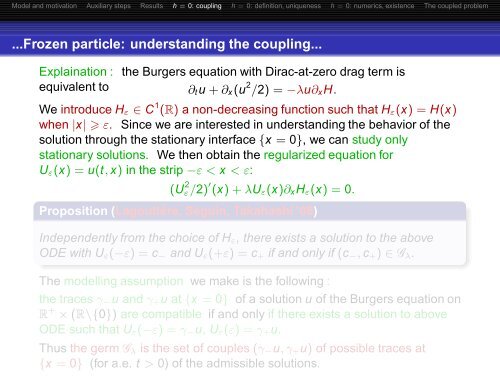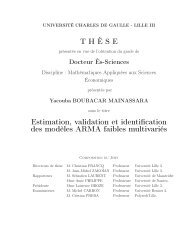A particle-in-Burgers model: theory and numerics - Laboratoire de ...
A particle-in-Burgers model: theory and numerics - Laboratoire de ...
A particle-in-Burgers model: theory and numerics - Laboratoire de ...
Create successful ePaper yourself
Turn your PDF publications into a flip-book with our unique Google optimized e-Paper software.
Mo<strong>de</strong>l <strong>and</strong> motivation Auxiliary steps Results h = 0: coupl<strong>in</strong>g h = 0: <strong>de</strong>f<strong>in</strong>ition, uniqueness h = 0: <strong>numerics</strong>, existence The coupled problem<br />
...Frozen <strong>particle</strong>: un<strong>de</strong>rst<strong>and</strong><strong>in</strong>g the coupl<strong>in</strong>g...<br />
Expla<strong>in</strong>ation : the <strong>Burgers</strong> equation with Dirac-at-zero drag term is<br />
equivalent to ∂tu +∂x(u 2 /2) = −λu∂xH.<br />
We <strong>in</strong>troduce Hε ∈ C 1 (R) a non-<strong>de</strong>creas<strong>in</strong>g function such that Hε(x) = H(x)<br />
when |x| ε. S<strong>in</strong>ce we are <strong>in</strong>terested <strong>in</strong> un<strong>de</strong>rst<strong>and</strong><strong>in</strong>g the behavior of the<br />
solution through the stationary <strong>in</strong>terface{x = 0}, we can study only<br />
stationary solutions. We then obta<strong>in</strong> the regularized equation for<br />
Uε(x) = u(t, x) <strong>in</strong> the strip −ε < x < ε:<br />
(U 2 ε/2) ′ (x)+λUε(x)∂xHε(x) = 0.<br />
Proposition (Lagoutière, Segu<strong>in</strong>, Takahashi ’08)<br />
In<strong>de</strong>pen<strong>de</strong>ntly from the choice of Hε, there exists a solution to the above<br />
ODE with Uε(−ε) = c− <strong>and</strong> Uε(+ε) = c+ if <strong>and</strong> only if (c−, c+) ∈ Gλ.<br />
The <strong>mo<strong>de</strong>l</strong>l<strong>in</strong>g assumption we make is the follow<strong>in</strong>g :<br />
the traces γ−u <strong>and</strong> γ+u at {x = 0} of a solution u of the <strong>Burgers</strong> equation on<br />
R + ×(R\{0}) are compatible if <strong>and</strong> only if there exists a solution to above<br />
ODE such that Uε(−ε) = γ−u, Uε(ε) = γ+u.<br />
Thus the germ Gλ is the set of couples(γ−u,γ+u) of possible traces at<br />
{x = 0} (for a.e. t > 0) of the admissible solutions.
















